 |
Fort William Augustus
Grassy Island, Nova Scotia, Canada
|
|
 |
Constructed: 1723-1724
Used by: England
Conflict in which it participated:
Never-ending, nameless colonial clashes
Also known as: Grassy Island Fort,
Fort Phillips
|
The Mi'kmaq people, who inhabited what it today Nova Scotia for who knows how long, were no doubt incredulous when French persons showed up in 1605 and started building things. Europeans couldn't have been new to the Mi'kmaq, as these pale fellows had been poking at the shore and fishing with wild abandon around Nova Scotia shortly after Columbus' "discovery" of the western hemisphere (which was in 1492), and had since been attempting unsuccessfully to establish permanent settlements. |
 |
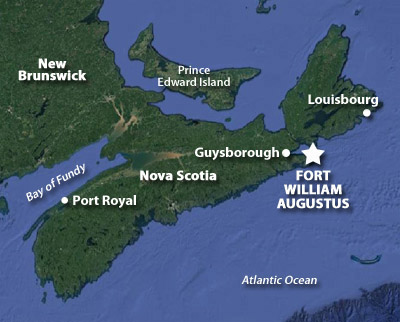 |
|
But these 1605 Frenchmen were different: They were Frenchmen of the can-do 17th century, and they built what would become the first permanent European settlement north of Florida in the New World, claiming all of the Mi'kmaq lands for the King of France. For some reason the Mi'kmaq tolerated this odd behavior, trading with the Frenchmen and living in relative peace and prosperity with them. This was the beginning of Acadia, a French colony which, by 1720, claimed land as far north as Prince of Wales Fort in today's Churchill, Manitoba, and a few hundred miles west of the Mississippi River at the colony's southern extremity. The little fishing village of Canso was permanently established in 1605. |
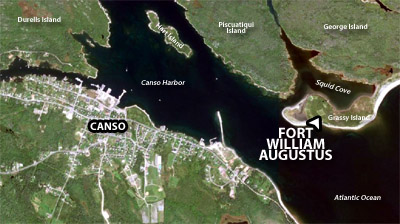 Where is it? Oh, there it is. |
 |
French folks had been trying to make Canso a reality as early as 1518, but being located at what can charitably described as the "ass-end of nowhere" made it a challenging location at which to accomplish much of anything.
French knight (yes, they still had "knights" in the 17th century)/sailor Isaac de Razilly (1587-1635) arrived in 1632, with 300 "elite" men. He took the town of Port Royal from the Scots (there seems to have been no fighting involved in this feat) who had established it in 1629, and made it the capital of Acadia.
|
|
|
More importantly for our purposes, Governor Razilly built Fort Saint-François 1634: The area's first fort! He did this at either Canso or Guysborough (also known as Chedabucto), the latter being a town he had established at the extent of the bay at whose mouth Canso sits, in 1634. Wherever it was, was it a starfort? It seems likely that it would have had some manner of bastioned trace, but forts in this region at the time in question tended to be built and destroyed at a steady clip....and it's quite possible that there was a Fort St. Francis at both locations at one point or another. If there are any remains of this fort at Guysborough or Canso, I sure can't see them via satellite. Let us know if there's anything left, Nova Scotians!
|
A small amount of research into the following decades of Nova Scotian history reveals a surprising fact: The English and the French did not care for each other. In fact they may still not care for each other all that much, but they're doing a fairly decent job of accepting each others' existence these days. It should be noted that a whole lot of Englishmen died for France during the First (1914-1918) and Second (1939-1945) World Wars. But one digresses.
An English cartographer and ship's captain with the delightful name of Cyprian Southack (1662-1745) set up (what he planned to be) a permanent fishing station at what is today Shelburne, Nova Scotia, in 1715. There had been an Acadian fishing village called Port Razoir at this spot at Nova Scotia's southwestern extent, but the English had threatened and imprisoned its inhabitants until those Acadian folks left, some years previously.
|
 |
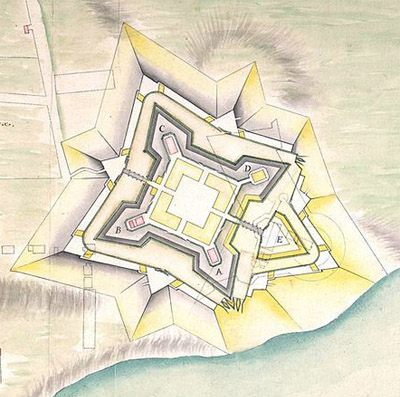 Port Royal in 1702, which had as lovely a starfort as that for which one might wish. Fort Anne, at what is now called Annapolis Royal, is still quite a sight today! Port Royal in 1702, which had as lovely a starfort as that for which one might wish. Fort Anne, at what is now called Annapolis Royal, is still quite a sight today! |
|
The Mi'kmaq got along with the Acadians way better than they got along with the English, so much so that they raided and burned Southack's village to the ground just a few months after he had established it. Southack either commanded or influenced the doings of the Royal Navy's HMS Squirrel, a 24-gun "sixth-rate" ship: With 24 guns on a single deck, a sixth-rate would almost, but not quite, be classified as a frigate...but in a time and place where there was frequently nothing bigger than a canoe paddling about, a sixth-rate was an awesome projector of power indeed. On September 17-24, 1718, the Squirrel attacked the Acadians at Canso, laid siege to Fort St. Francis at Guysborough (oh, I guess it was at Guysborough after all!), killed and imprisoned lots of Acadians, and ultimately pillaged and burned Guysborough.
Southack captured two French ships that had been at Guysborough, and then ejected his Acadian prisoners onto the Canso Islands. The town of Canso existed at that time on what is today Grassy Island, but Canso had been razed by the Squirrel's earlier attack, so those released prisoners faced a bleak future, having been left with no supplies or warm clothing.
|
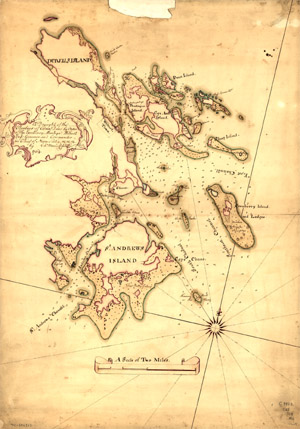
Canso Harbor in 1764, inexplicably tilted clockwise just a smidge? Canso had been moved from the islands onto the mainland by this point, and temporarily named Wilmot Town, after Montague Wilmot (d. 1766), English Governor of Nova Scotia.
Right: The 1724 iteration of Fort William Augustus, from a contemporary drawing. A starfort by any measure. |
 |
The Squirrel Affair, as these events came to be known, was the cause for Fort William Augustus to be built. While destroying two towns, killing lots of people and dumping still more folks on a barren rock is pretty bad, I found myself hoping that the Squirrel Affair would have referred to atrocities committed by His Majesty's Genetically Enhanced Rabid Squirrel Legion. But no such luck. 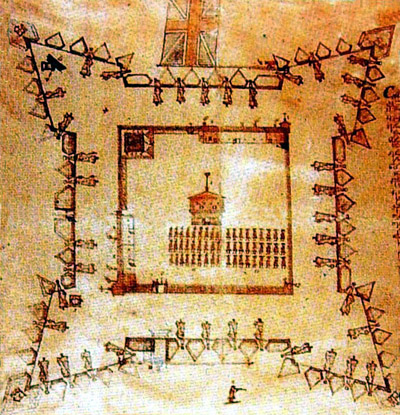 |
|
|
Having reaped the whirlwind (well, actually kind of following the pre-existing whirlwind?) and correctly anticipating revenge, Southack urged Governor of Nova Scotia Richard Philipps (1661-1750) to fortify Canso, which had become an English possession. Work on the first Fort William Augustus, named for King George II (1683-1760)'s son Prince William (1721-1765), began in early 1720. This fort was also known as Fort Philipps, after the governor who was presumably paying for its construction. Perhaps the persons who were building and manning the fort named it after whichever rich influential dude with whom they were presently conversing, just to keep the money flowing?
The fortification built in 1720 was our fort's first iteration, and was likely little more than an earthen redoubt. Star-shaped? One would like to think so, but who has time to make a nice pointy starfort when the Injuns are a-comin'?
|
Indeed, work had not commenced very far when the Mi'kmaq came to visit on August 17, 1720, along with a group of suitably enraged French fishermen. The attackers killed three men and did a "significant amount" of damage to the fœtal fort, but the New Englanders captured 21 of them. The inflicted damage couldn't have been all that significant, as the redoubt was completed in the fall of 1720.
|
 |
 Fort William Augustus, from an informational sign at the fort. Merci beaucoup to ns1763.ca for the pix of present-day Fort William Augustus! Bandwidth limit exceeded. Fort William Augustus, from an informational sign at the fort. Merci beaucoup to ns1763.ca for the pix of present-day Fort William Augustus! Bandwidth limit exceeded. |
|
The construction of the fort of our current interest at the location of our present contemplation was a violation of long-standing agreements betwixt the Mi'kmaq and Europeans...and that the Mi'kmaq had involved themselves in what had been nominally a European scuffle was also considered an affront. All of this dovetailed nicely with the rising tensions that would erupt into Father Rale's War (1722-1725), which pitted New Englanders against Indians of the Wabanaki Confederacy, who were allied with France. This conflict was known by several different names, but we're going with the version named for French Jesuit missionary Father Sébastien Rale (1657-1724), who led the Indians on their quest for territorial justice (and scalps).
|
|
|
|
Ultimately, neither the anti-English Indians nor Father Rale did well in this conflict. The Indians and French lost access to Maine, and Father Rale was killed at the Battle of Norridgewock (August 22,1724). It was during this war, however, that Fort William Augustus became an actual starfort, of earth and wooden construction.
Peace more or less reigned for 20 years until the folks in Europe came up with something else to fight over: Holy Roman Emperor Charles VI (1685-1740) did what humans do and passed away, with his only heir being Maria Theresa (1717-1780), an admitted woman. Women can't be Holy Roman Emperors, bellowed France and Prussia! Just watch a woman be a Holy Roman Emperor, shrieked England and the Dutch Empire! What did any of this have to do with the New World? Aaaabsolutely nothing, but Europe's War of the Austrian Succession (1740-1748) had reach, and it eventually sparked conflicts in India, Scotland, and of course North America.
The American version of this war was known as King George's War (1744-1748), which began with the destruction of Canso! French troops from Louisbourg, further up the coast of Nova Scotia on Cape Breton Island, descended on Canso in the night on May 24, 1744. Fort William Augustus had been replaced with a blockhouse and a few other structures in the 1730's, but Canso was unprepared for war, and the French and the good ole Mi'kmaq did away with these fortifications in short order.
A lightning strike, a huge victory, before the folks in Canso may have even been fully aware that there was a war! The French had chosen the location of their first attack with care: Canso, with its lovely harbor, was a logical staging area for an English attack on Louisbourg.
|
But perhaps the French should have drained Canso's harbor, because staging an English attack on Louisbourg was exactly what it was used for anyway, in 1745. May and June of that year saw the Siege of Louisbourg, the outcome of which was the French being tipped out of their lovely starfort there.
A new blockhouse was built at Canso to protect this endeavor's starting point, which blockhouse was named Fort Prince William, after the same guy for whom Fort William Augustus had been named.
|
 |
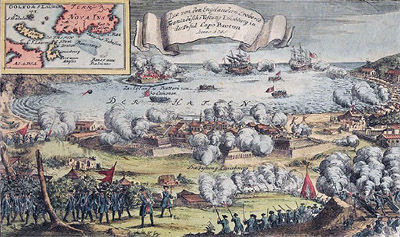 The Siege of Louisbourg, 1745. Louisbourg had such a pretty starfort. Which is also gone, also of course. The Siege of Louisbourg, 1745. Louisbourg had such a pretty starfort. Which is also gone, also of course. |
|
One would think that by this point, prince William would have been wondering what happened to the other fort named after him at Canso...but there were likely many forts named after the dude, and he couldn't be expected to devote the time and energy needed to keep track of them, and it's not as though he were gallivanting through Nova Scotia on a regular basis.
King George's War ended three years later. The Treaty of Aix-la-Chapelle returned Louisbourg to the French, in fact all territorial gains that were made on either side were nullified by the treaty. All the fighting, including the death of an estimated 8% of Massachusetts' adult male population, had resolved nothing...and had just steeled the determination of those who had survived for further bloodshed.
And bloodshed there would be, but it wouldn't involve Fort William Augustus, because there was no longer a Fort William Augustus! The English established Halifax in 1749, and made it their new capital of Nova Scotia. On the eastern coast of the island, Halifax was easier to support from the mother country than had been the case with the old capital at Annapolis Royal (the City Previously Known as Port Royal), but it also lessened the importance of Canso...not so much that French, Indian and eventually American persons wouldn't continue to raid Canso, however.
|
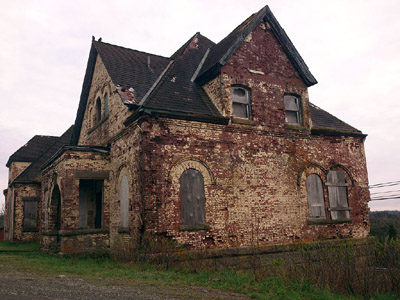
Canso's aging telegraph cable building, which received the first distress call from the RMS Titanic on April 14, 1912. |
 |
Canso was raided twice during Father Le Loutre's War (1749-1755) and thrice during the American Revolutionary War (1775-1783). Whether Fort Prince William, Canso's blockhouse built during King George's War, figured in the town's defense or was even still extant, is anybody's guess.
Grassy Island Fort, Fort William Augustus' more verdant moniker, was named a National Historic Site of Canada in 1962. Visitors can gravely regard the grassy remains of the 1720 redoubt, the equally grassy remains of the starfort that was built by 1724, and what's left of the 1735 blockhouse. Did any of these fortifications accomplish their intended goals? Canso was frequently raided by enemies before, during and after the times there were forts on Grassy Island. |
|
|
In the end, the Acadians and French were expelled from Nova Scotia, and while Mi'kmaq still reside on that island, if they remain intent on doing away with the English, they're playing an extremely long game...so we can chalk that up as a win for Fort William Augustus!
A big 谢谢 to Taiwanese starfort enthusiast Adam Snyder, who found Fort William Augustus for us!
|
|
|
|
|
|
 |




